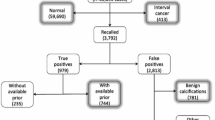Abstract
Almost half of all breast cancers are associated with calcifications on mammography; in many cases, calcifications are the only sign of breast cancer. However, calcifications may also occur in a variety of benign breast changes [1], and careful classification and interpretation of breast calcifications is the key to a correct diagnosis. It is also important to realize that a large overlap between benign and malignant calcifications exists (Fig. 1), and often, confirmation or exclusion of malignancy can only be achieved by obtaining tissue for histological analysis. There are several criteria by which benign and malignant breast calcifications can be distinguished, such as size, number, morphology, distribution, change over time, and associated findings or symptoms [2]. The Breast Imaging Reporting and Data System (BI-RADS®) Atlas of the American College of Radiology (ACR) provides an organized framework for description and classification of mammographic calcifications [3] and has found wide-spread acceptance around the world. Wherever applicable, standardized terms from the BI-RADS® lexicon are used in this manuscript.
Access this chapter
Tax calculation will be finalised at checkout
Purchases are for personal use only
Similar content being viewed by others
References
Tse GM, Tan PH, Pang AL et al (2008) Calcification in breast lesions: pathologists’ perspective. J Clin Pathol 61:145–151.
Demetri-Lewis A, Slanetz PJ, Eisenberg RL (2012) Breast calcifications: the focal group. AJR Am J Roentgenol 198:W325–W343.
Burnside ES, Ochsner JE, Fowler KJ et al (2007) Use of microcalcification descriptors in BI-RADS 4th edition to stratify risk of malignancy. Radiology 242:388–395.
American College of Radiology (2003) ACR BI-RADS®. Breast Imaging and Reporting Data System, Breast Imaging Atlas. Mammography, Breast Ultrasound, Magnetic Resonance Imaging. American College of Radiology, Reston, VA.
Diekmann F, Diekmann S, Bick U, Hamm B (2002) Reduceddose digital mammography of skin calcifications. AJR Am J Roentgenol 178:473–474.
Monsees BS (1995) Evaluation of breast microcalcifications. Radiol Clin North Am 33:1109–1121.
Bassett LW (1992) Mammographic analysis of calcifications. Radiol Clin North Am 30:93–105.
Sickles EA (1986) Breast calcifications: mammographic evaluation. Radiology 160:289–293.
Cowen AR, Launders JH, Jadav M, Brettle DS (1997) Visibility of microcalcifications in computed and screen-film mammography. Phys Med Biol 42:1533–1548.
Karssemeijer N, Frieling JTM, Hendriks JHCL (1993) Spatial resolution in digital mammography. Invest Radiol 28:413–419.
Graf O, Berg WA, Sickles EA (2013) Large rodlike calcifications at mammography: analysis of morphologic features. AJR Am J Roentgenol 200:299–303.
Hofvind S, Iversen BF, Eriksen L et al (2011) Mammographic morphology and distribution of calcifications in ductal carcinoma in situ diagnosed in organized screening. Acta Radiol 52:481–487.
Bent CK, Bassett LW, D’Orsi CJ, Sayre JW (2010) The positive predictive value of BI-RADS microcalcification descriptors and final assessment categories. AJR Am J Roentgenol 194:1378–1383.
Berg WA, Arnoldus CL, Teferra E, Bhargavan M (2001) Biopsy of amorphous breast calcifications: pathologic outcome and yield at stereotactic biopsy. Radiology 221:495–503.
Sickles EA (1991) Periodic mammographic follow-up of probably benign lesions: results in 3,184 consecutive cases. Radiology 179:463–468.
Del Turco MR, Mantellini P, Ciatto S et al (2007) Full-field digital versus screen-film mammography: comparative accuracy in concurrent screening cohorts. AJR Am J Roentgenol 189:860–866.
Vigeland E, Klaasen H, Klingen TA et al (2008) Full-field digital mammography compared to screen film mammography in the prevalent round of a population-based screening programme: the Vestfold County Study. Eur Radiol 18:183–191.
Bluekens AM, Holland R, Karssemeijer N et al (2012) Comparison of digital screening mammography and screen-film mammography in the early detection of clinically relevant cancers: a multicenter study. Radiology 265:707–714.
Bick U, Diekmann F (2007) Digital mammography: what do we and what don’t we know? Eur Radiol 17:1931–1942.
Fallenberg EM, Dimitrijevic L, Diekmann F et al (2013) Impact of magnification views on the characterization of microcalcifications in digital mammography. Fortschr Röntgenstr Doi:10.1055/s-0033-1350572.
Spangler ML, Zuley ML, Sumkin JH et al (2011) Detection and classification of calcifications on digital breast tomosyn-thesis and 2D digital mammography: a comparison. AJR Am J Roentgenol 196:320–324.
Gunhan-Bilgen I, Oktay A (2007) Management of microcalcifications developing at the lumpectomy bed after conservative surgery and radiation therapy. AJR Am J Roentgenol 188:393–398.
Schueller G, Schueller-Weidekamm C, Helbich TH (2008) Accuracy of ultrasound-guided, large-core needle breast biopsy. Eur Radiol 18:1761–1773.
Weigel S, Decker T, Korsching E (2011) Minimal invasive biopsy results of “uncertain malignant potential” in digital mammography screening: high prevalence but also high predictive value for malignancy. Fortschr Röntgenstr 183:743–748.
Penco S, Rizzo S, Bozzini AC et al (2010) Stereotactic vacuum-assisted breast biopsy is not a therapeutic procedure even when all mammographically found calcifications are removed: analysis of 4,086 procedures. AJR Am J Roentgenol 195:1255–1260.
Jackman RJ, Marzoni FA, Jr., Rosenberg J (2009) False-negative diagnoses at stereotactic vacuum-assisted needle breast biopsy: long-term follow-up of 1,280 lesions and review of the literature. AJR Am J Roentgenol 192:341–351.
Author information
Authors and Affiliations
Editor information
Editors and Affiliations
Rights and permissions
Copyright information
© 2014 Springer-Verlag Italia
About this chapter
Cite this chapter
Bick, U. (2014). Mammography: How to Interpret Microcalcifications. In: Hodler, J., von Schulthess, G.K., Kubik-Huch, R.A., Zollikofer, C.L. (eds) Diseases of the Abdomen and Pelvis 2014–2017. Springer, Milano. https://doi.org/10.1007/978-88-470-5659-6_40
Download citation
DOI: https://doi.org/10.1007/978-88-470-5659-6_40
Publisher Name: Springer, Milano
Print ISBN: 978-88-470-5658-9
Online ISBN: 978-88-470-5659-6
eBook Packages: MedicineMedicine (R0)




